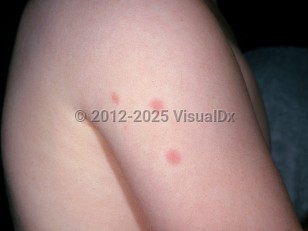Bedbug bite in Adult
Alerts and Notices
Important News & Links
Synopsis

Bedbugs (Cimex lectularis) are 4-5 mm ovoid, flat, wingless, red-brown, nocturnal, blood-sucking insects. The insects hide during the day in the seams of mattresses, in the crevices of box springs, and in the cracks of floors and walls. Bedbugs require a blood meal to progress in their life cycle. The insects feed weekly and prefer to bite in the predawn hours. While a blood meal is required to advance in the life cycle, bedbugs have been known to survive up to 12 months without a blood meal. In the absence of a human host, bedbugs may feed on other animals. The bedbug can travel by concealing itself or its eggs within the dark recesses of suitcases and other personal effects, including clothing.
Bedbugs have afflicted humans for thousands of years but became uncommon after World War II because of widespread use of modern insecticides. Beginning in 1995, a resurgence in bedbug infestations was noted, with rates almost doubling annually in North America, Western Europe, and Australia.
Increased national and international tourism, changes in pesticide use (including a prohibition on DDT), and use of recycled mattresses are thought to contribute to this epidemic of bedbug activity. Contrary to popular belief, cleanliness and hygiene have little impact on bedbug infestation. The insects are attracted to humans based on temperature and carbon dioxide production. Bedbugs are most prevalent in urban areas, likely due to population density and/or crowding.
At present, it is not believed that bedbugs are important vectors of disease transmission, such as human immunodeficiency virus (HIV) or hepatitis B or C. Patients with bedbug bites often come to medical attention seeking relief of resultant pruritus and skin lesions.
Bedbugs have afflicted humans for thousands of years but became uncommon after World War II because of widespread use of modern insecticides. Beginning in 1995, a resurgence in bedbug infestations was noted, with rates almost doubling annually in North America, Western Europe, and Australia.
Increased national and international tourism, changes in pesticide use (including a prohibition on DDT), and use of recycled mattresses are thought to contribute to this epidemic of bedbug activity. Contrary to popular belief, cleanliness and hygiene have little impact on bedbug infestation. The insects are attracted to humans based on temperature and carbon dioxide production. Bedbugs are most prevalent in urban areas, likely due to population density and/or crowding.
At present, it is not believed that bedbugs are important vectors of disease transmission, such as human immunodeficiency virus (HIV) or hepatitis B or C. Patients with bedbug bites often come to medical attention seeking relief of resultant pruritus and skin lesions.
Codes
ICD10CM:
W57.XXXA – Bitten or stung by nonvenomous insect and other nonvenomous arthropods, initial encounter
SNOMEDCT:
242649000 – Bite of bed bug
W57.XXXA – Bitten or stung by nonvenomous insect and other nonvenomous arthropods, initial encounter
SNOMEDCT:
242649000 – Bite of bed bug
Look For
Subscription Required
Diagnostic Pearls
Subscription Required
Differential Diagnosis & Pitfalls

To perform a comparison, select diagnoses from the classic differential
Subscription Required
Best Tests
Subscription Required
Management Pearls
Subscription Required
Therapy
Subscription Required
References
Subscription Required
Last Reviewed:05/04/2017
Last Updated:05/04/2017
Last Updated:05/04/2017
 Patient Information for Bedbug bite in Adult
Patient Information for Bedbug bite in Adult
Premium Feature
VisualDx Patient Handouts
Available in the Elite package
- Improve treatment compliance
- Reduce after-hours questions
- Increase patient engagement and satisfaction
- Written in clear, easy-to-understand language. No confusing jargon.
- Available in English and Spanish
- Print out or email directly to your patient
Upgrade Today

Bedbug bite in Adult

